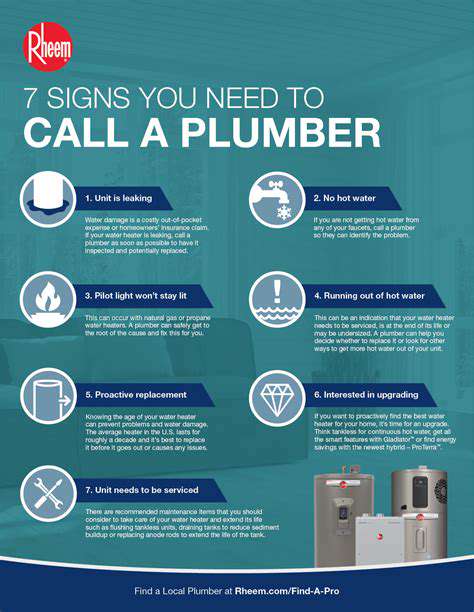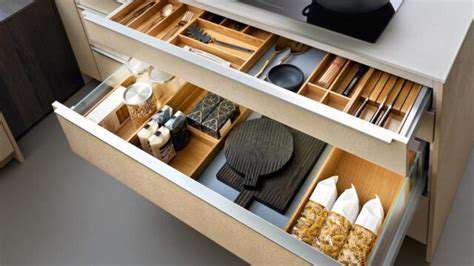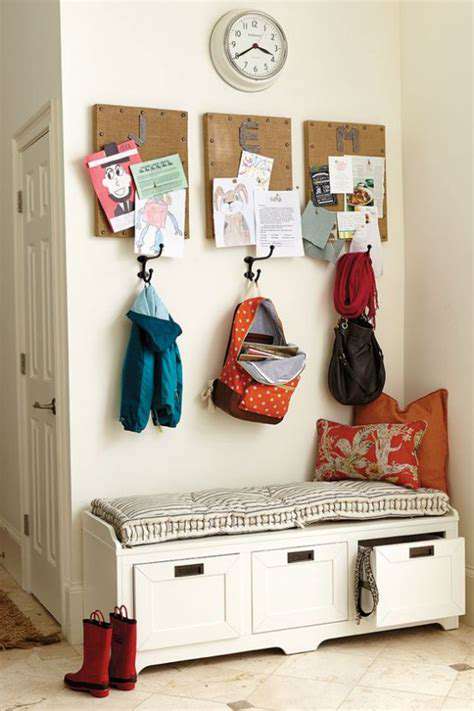Guide to Basic Plumbing Repairs at Home
Identifying the Leak
Before diving into the repair process, you need to precisely identify the source of the leak. A dripping faucet is obvious, but sometimes the leak might be hidden behind walls or under sinks. Carefully inspect the faucet's base, the supply lines, and any visible connections. Pay attention to any unusual moisture or dampness around the fixtures. This initial step of precise identification is crucial to effective troubleshooting and prevents unnecessary work.
Look closely for signs of water accumulation. This could be a drip, a slow leak, or even a steady stream. Understanding the nature of the leak will help you determine the appropriate repair method and tools. Ignoring a subtle leak could lead to costly water damage and higher utility bills over time.
Gathering the Necessary Tools
Having the right tools on hand will save you time and frustration during the repair. You'll likely need adjustable pliers, a wrench (likely a basin wrench or adjustable wrench), pipe sealant, Teflon tape, a bucket, and a drain pan to catch any drips or spills. Ensure that all your tools are clean and in good working order to prevent damage to the faucet or surrounding components.
Having a flashlight handy can be very helpful for inspecting areas that may be difficult to see. A small amount of rags or paper towels will also be helpful for cleaning up any drips or spills during the repair. A plumber's helper or assistant can greatly reduce the time spent on the job, so if assistance is available, use it!
Shutting Off the Water Supply
Before you begin any work, it's critical to shut off the water supply to the faucet. Locate the shut-off valves, which are typically located near the water supply lines. Turn both valves clockwise to completely shut off the water flow. This prevents water damage during the repair process and ensures your safety while working with plumbing.
Double-check that the water is completely shut off by running your tap; if water continues to flow, ensure you have located the correct valves and tightened them fully.
Disassembling the Faucet
Carefully remove the handles and any decorative components from the faucet. Refer to the manufacturer's instructions for your specific faucet model if available. These instructions often detail the precise steps to follow for safe disassembling. Improper disassembly can lead to further complications or damage.
Be mindful of the position of any springs, washers, or other small parts. Take photos or make detailed notes of the disassembly process to ensure the faucet is reassembled correctly. Thoroughly inspect each component for damage or wear and tear.
Replacing Worn Parts
Inspect the parts for any signs of damage, such as cracks, corrosion, or wear. Replace any damaged or worn parts with new, high-quality replacements. Use the correct type and size of parts to ensure a proper fit and secure seal. Properly securing the parts is crucial to prevent future leaks.
Apply the appropriate sealant or Teflon tape to any threads to create a watertight seal. Over-tightening can damage the components, so use a moderate amount of pressure.
Reassembling and Testing
Carefully reassemble the faucet, following the reverse order of disassembly. Ensure all parts are correctly aligned and tightened securely. Do not overtighten any connections.
Once reassembled, turn the water supply back on slowly. Monitor the faucet for any leaks. If there are no leaks, you've successfully repaired your leaky faucet. If leaks persist, recheck your work for any missed steps or mistakes in the reassembly process.
Troubleshooting Toilet Issues: From Clogs to Leaks
Understanding Common Toilet Clogs
Toilet clogs are a frustrating plumbing problem, often stemming from flushed items that aren't meant for the toilet. Understanding the source of the clog is crucial to effective troubleshooting. For instance, sanitary napkins, paper towels, and even excessive amounts of toilet paper can quickly create blockages. Identifying the culprit can help you avoid future issues and prevent costly repairs by taking steps to improve your flushing habits.
Additionally, gradual blockages caused by accumulated debris, such as hair, soap scum, and small pieces of food, can also contribute to toilet clogs. Regular maintenance, including periodic checks for foreign objects in the bowl, plays a vital role in preventing these issues.
Identifying Toilet Leaks
Toilet leaks, while seemingly minor, can lead to significant water waste and increased utility bills. Knowing the signs of a leak is essential for prompt action. A constant dripping sound, a visibly damp area around the base of the toilet, or a consistently high water level in the tank are all potential indicators. A slow leak can be particularly troublesome, as it often goes unnoticed for extended periods, leading to substantial water loss.
Addressing Slow Flushing Toilets
A slow-flushing toilet can be a nuisance, as it means multiple flushes are required to clear the bowl. This problem can result from several issues, including a partially clogged drainpipe, a faulty flapper, a problem with the fill valve, or even a low water level in the tank. Careful inspection of these components can often pinpoint the source of the problem and lead to a simple repair.
Unclogging a Toilet: Do-It-Yourself Techniques
For minor clogs, you can attempt a DIY approach using common household items. Plunging is a frequently used technique. Ensure the plunger is properly fitted to the bowl and create a good seal. Repeated pumping can often dislodge the clog and restore proper drainage. Alternatively, using a drain snake or a closet auger can be effective for more stubborn clogs.
Maintaining Toilet Water Levels
Maintaining the correct water level in your toilet tank is crucial for proper flushing and to avoid water waste. A fluctuating water level could indicate a leaky flapper or a faulty fill valve. Checking and replacing the flapper, as well as inspecting the fill valve, can resolve these issues. Ensuring the fill valve is functioning correctly is essential for optimal toilet performance.
When to Call a Plumber
While many minor toilet issues can be addressed with DIY methods, some problems require professional intervention. Severe clogs, persistent leaks, or issues with the toilet tank or base that you are unable to resolve yourself signify the need for a plumber's expertise. A plumber possesses the necessary tools and knowledge to tackle complex plumbing problems and ensure a lasting solution. Ignoring these issues can lead to further damage and greater expenses.
When to Call a Plumber

Plumbing Issues Requiring Immediate Attention
A sudden burst pipe can flood your home, causing significant damage and potential water damage. This is a critical situation that requires immediate intervention. Don't hesitate to call a plumber if you experience a leak or a burst pipe as delays can worsen the problem and increase the cost of repairs. Water damage can lead to mold growth and structural problems, resulting in much larger and more costly issues down the line.
Similarly, a clogged drain that is backing up into your sink or shower needs immediate attention. This can lead to unpleasant odors and potential damage to your plumbing system. A slow drain or a completely blocked drain can lead to serious problems, including sewage backups, which can be very costly to fix.
Clogged Toilets and Drains
A clogged toilet is a common plumbing issue, but it can quickly become a major inconvenience if not addressed promptly. Ignoring a clogged toilet can lead to unpleasant smells and, potentially, overflow into your bathroom. A clogged toilet can also cause a backup in the plumbing system, affecting other parts of your home. Professional intervention is often necessary to clear a stubborn clog, especially if it involves a significant amount of debris or if the clog is recurring.
Leaking Faucets and Pipes
A dripping faucet may seem like a minor issue, but it can waste gallons of water over time. This seemingly small leak can accumulate significant water waste and contribute to your monthly water bills. Ignoring a leak can also lead to potential water damage to your home. Over time, a persistent leak can damage flooring, walls, and even the structure of your house.
A leak in a pipe can also cause water damage in a similar manner to a burst pipe. Addressing these leaks quickly is essential to prevent costly repairs and minimize damage to your property.
Strange Noises Coming from Your Pipes
Unusual noises, like banging, gurgling, or hissing, coming from your pipes may indicate a problem that requires attention. These sounds could be signs of air pockets in the system, loose connections, or even a more serious issue like a failing water heater. Ignoring these noises can potentially lead to more significant plumbing problems and costly repairs in the future. A qualified plumber can diagnose the source of the noise and provide a solution to prevent further damage.
Low Water Pressure
Low water pressure can be a frustrating issue, impacting your daily routines and potentially indicating a problem with your plumbing system. Decreased water pressure may be a sign of a clog or a leak in your plumbing system. This often requires a plumber to thoroughly inspect your system to identify the root cause of the problem and implement appropriate solutions. If the pressure is consistently low, it's important to have a professional assess the situation to avoid further issues.
Frozen Pipes
Frozen pipes can be a significant plumbing emergency, particularly during cold weather. Frozen pipes can burst, causing extensive water damage and potentially leading to significant property damage. Preventative measures, such as insulation and proper water shut-offs, are vital during freezing temperatures. If you suspect frozen pipes, turn off the water supply to the affected area and immediately contact a plumber.
Recurring Plumbing Problems
If you're experiencing recurring plumbing issues, such as frequent clogs, leaks, or slow drains, it's crucial to address the underlying cause. These recurring problems can indicate a larger plumbing system issue that requires a more comprehensive inspection and repair. A plumber can diagnose the root cause of the problem, whether it's a faulty fixture, a clog in a drain line, or a more significant structural problem. Regular preventative maintenance can often help avoid these recurring plumbing issues. Proactive maintenance can save you a lot of time, money, and headaches in the future.






![Guide to Learning About [Specific Topic, e.g., Climate Change]](/static/images/31/2025-05/TheUnfoldingImpactsofaChangingClimate.jpg)
![Best Smart Vacuum Cleaners [2025 Review]](/static/images/31/2025-05/SmartFeaturesandConnectivity3AStreamliningYourCleaningRoutine.jpg)



